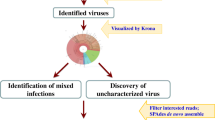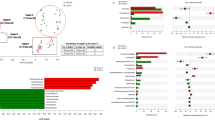Abstract
Porcine epidemic diarrhea (PED) is a devastating disease in livestock industry. Most of the previous studies related to the PED were focused on the pathology and etiology of porcine epidemic diarrhea virus (PEDV). A little was known regarding the status of gut microbiota after piglets infected by PEDV. In this study, aided by metagenome sequencing technology, gut microbiota profiles in feces of viral diarrhea (VD) and viral control (VC) piglets were investigated. The results showed that the abundance of four dominant phyla (Fusobacteria, Actinobacteria, Verrucomicrobia, and Proteobacteria) in feces was affected greatly by porcine epidemic diarrhea. Especially, the abundance of Fusobacteria was higher in VD piglets (36 %) than in VC piglets (5 %). On the contrary, the Verrucomicrobia was detected in lower distribution proportion in VD piglets (around 0 %) than in VC piglets (20 %). Furthermore, 25 genera were significantly different between VC and VD piglets at the genus level. Among the 25 genera, Leptotrichia belonging to Fusobacteria was remarkably lower in VC piglets than in VD piglets. Akkermansia belonging to Verrucomicrobia was higher in VC piglets than in VD piglets. Our findings implicated that the gut microbiota associated with PED significantly provided an insight into the pathology and physiology of PED.




Similar content being viewed by others
References
Atarashi K, Tanoue T, Shima T, Imaoka A, Kuwahara T, Momose Y, Cheng GH, Yamasaki S, Saito T, Ohba Y, Taniguchi T, Takeda K, Hori S, Ivanov II, Umesaki Y, Itoh K, Honda K (2011) Induction of colonic regulatory T cells by indigenous clostridium species. Science 331(6015):337–341. doi:10.1126/science.1198469
Candela M, Perna F, Carnevali P, Vitali B, Ciati R, Gionchetti P, Rizzello F, Campieri M, Brigidi P (2008) Interaction of probiotic Lactobacillus and Bifidobacterium strains with human intestinal epithelial cells: adhesion properties, competition against enteropathogens and modulation of IL-8 production. Int J Food Microbiol 125(3):286–292. doi:10.1016/j.ijfoodmicro.2008.04.012
Cani PD, Geurts L, Matamoros S, Plovier H, Duparc T (2014) Glucose metabolism: focus on gut microbiota, the endocannabinoid system and beyond. Diabetes Metab 40(4):246–257. doi:10.1016/j.diabet.2014.02.004
Fernandez MF, Boris S, Barbes C (2003) Probiotic properties of human lactobacilli strains to be used in the gastrointestinal tract. J Appl Microbiol 94(3):449–455. doi:10.1046/j.1365-2672.2003.01850.x
Gordon JI, Hooper LV, McNevin MS, Wong M, Bry L (1997) Epithelial cell growth and differentiation. 3. Promoting diversity in the intestine: conversations between the microflora, epithelium, and diffuse GALT. Am J Physiol 273(3):565–570
Goto M, Hitomi S, Ishii T (2007) Bacterial arthritis caused by Leptotrichia amnionii. J Clin Microbiol 45(6):2082–2083. doi:10.1128/jcm.02441-06
Hagland HR, Soreide K (2015) Cellular metabolism in colorectal carcinogenesis: influence of lifestyle, gut microbiome and metabolic pathways. Cancer Lett 356(2):273–280. doi:10.1016/j.canlet.2014.02.026
Han YPW, Fardini Y, Chen C, Iacampo KG, Peraino VA, Shamonki JM, Redline RW (2010) Term stillbirth caused by oral Fusobacterium nucleatum. Obstet Gynecol 115(2):442–445
Han YW, Shen T, Chung P, Buhimschi IA, Buhimschi CS (2009) Uncultivated bacteria as etiologic agents of intra-amniotic inflammation leading to preterm birth. J Clin Microbiol 47(1):38–47. doi:10.1128/jcm.01206-08
Jimenez E, Sanchez B, Farina A, Margolles A, Rodriguez JM (2014) Characterization of the bile and gall bladder microbiota of healthy pigs. Microbiologyopen 3(6):937–949. doi:10.1002/mbo3.218
Kostic AD, Chun EY, Robertson L, Glickman JN, Gallini CA, Michaud M, Clancy TE, Chung DC, Lochhead P, Hold GL, El-Omar EM, Brenner D, Fuchs CS, Meyerson M, Garrett WS (2013) Fusobacterium nucleatum potentiates intestinal tumorigenesis and modulates the tumor-immune microenvironment. Cell Host Microbe 14(2):207–215. doi:10.1016/j.chom.2013.07.007
Langfeldt D, Neulinger SC, Stiesch M, Stumpp N, Bang C, Schmitz RA, Eberhard J (2014) Health- and disease-associated species clusters in complex natural biofilms determine the innate immune response in oral epithelial cells during biofilm maturation. FEMS Microbiol Lett 360(2):137–143. doi:10.1111/1574-6968.12596
Levesque CL, Hooda S, Swanson KS, de Lange K (2014) Alterations in ileal mucosa bacteria related to diet complexity and growth performance in young pigs. PLoS One 9(9):e108472. doi:10.1371/journal.pone.0108472
Ley RE, Hamady M, Lozupone C, Turnbaugh PJ, Ramey RR, Bircher JS, Schlegel ML, Tucker TA, Schrenzel MD, Knight R, Gordon JI (2008) Evolution of mammals and their gut microbes. Sci 320(5883):1647–1651. doi:10.1126/science.1155725
Mole B (2013) Deadly pig virus slips through US borders. Nature 499(7459):388
Olszak T, An DD, Zeissig S, Vera MP, Richter J, Franke A, Glickman JN, Siebert R, Baron RM, Kasper DL, Blumberg RS (2012) Microbial exposure during early life has persistent effects on natural killer t cell function. Sci 336(6080):489–493. doi:10.1126/science.1219328
Pensaert M, Callebaut P, DeBouck P (1982) Porcine epidemic diarrhea (PED) caused by a coronavirus. Present knowledge. Proc Congr Int Pig Vet Soc 7:52
Rist VTS, Eklund M, Bauer E, Sauer N, Mosenthin R (2012) Effect of feeding level on the composition of the intestinal microbiota in weaned piglets. J Anim Sci 90:19–21. doi:10.2527/jas52642
Rubinstein MR, Wang XW, Liu WD, Hao YJ, Cai GF, Han YPW (2013) Fusobacterium nucleatum promotes colorectal carcinogenesis by modulating E-cadherin/beta-catenin signaling via its FadA adhesin. Cell Host Microbe 14(2):195–206. doi:10.1016/j.chom.2013.07.012
Scher JU, Ubeda C, Artacho A, Attur M, Isaac S, Reddy SM, Marmon S, Neimann A, Brusca S, Patel T, Manasson J, Pamer EG, Littman DR, Abramson SB (2015) Decreased bacterial diversity characterizes the altered gut microbiota in patients with psoriatic arthritis, resembling dysbiosis in inflammatory bowel disease. Arthritis Rheumatol 67(1):128–139. doi:10.1002/art.38892
Shin NR, Lee JC, Lee HY, Kim MS, Whon TW, Lee MS, Bae JW (2014) An increase in the Akkermansia spp. population induced by metformin treatment improves glucose homeostasis in diet-induced obese mice. Gut 63(5):727–735. doi:10.1136/gutjnl-2012-303839
Song D, Park B (2012) Porcine epidemic diarrhoea virus: a comprehensive review of molecular epidemiology, diagnosis, and vaccines. Virus Genes 44(2):167–175. doi:10.1007/s11262-012-0713-1
Sun RQ, Cai RJ, Chen YQ, Liang PS, Chen DK, Song CX (2012) Outbreak of porcine epidemic diarrhea in suckling piglets, China. Emerg Infect Dis 18(1):161–163. doi:10.3201/eid1801.111259
Swidsinski A, Doerffel Y, Loening-Baucke V, Theissig F, Rueckert JC, Ismail M, Rau WA, Gaschler D, Weizenegger M, Kuehn S, Schilling J, Doerffel WV (2011) Acute appendicitis is characterised by local invasion with Fusobacterium nucleatum/necrophorum. Gut 60(1):34–40. doi:10.1136/gut.2009.191320
Thilesen CM, Nicolaidis M, Lökebo JE, Falsen E (2007) Leptotrichia amnionii, an emerging pathogen of the female urogenital tract. J Clin Microbiol 45(7):2344–2347
Yoneda S, Loeser B, Feng J, Dmytryk J, Qi F, Merritt J (2014) Ubiquitous sialometabolism present among oral fusobacteria. PLoS One 9(6):e99263. doi:10.1371/journal.pone.0099263
Zhao W, Wang Y, Liu S, Huang J, Zhai Z, He C, Ding J, Wang J, Wang H, Fan W, Zhao J, Meng H (2015) The dynamic distribution of porcine microbiota across different ages and gastrointestinal tract segments. PLoS One 10(2):e0117441. doi:10.1371/journal.pone.0117441
Acknowledgments
This work was supported by the National High Technology Research and Development Program of China (Grant No. 2011AA100901), the National Science Foundation of China (Grant No. 31272430), and Agriculture Development through Science and Technology Key Project of Shanghai (Grant No. 2012,2-3).
Author information
Authors and Affiliations
Corresponding authors
Electronic supplementary material
Below is the link to the electronic supplementary material.
Rights and permissions
About this article
Cite this article
Liu, S., Zhao, L., Zhai, Z. et al. Porcine Epidemic Diarrhea Virus Infection Induced the Unbalance of Gut Microbiota in Piglets. Curr Microbiol 71, 643–649 (2015). https://doi.org/10.1007/s00284-015-0895-6
Received:
Accepted:
Published:
Issue Date:
DOI: https://doi.org/10.1007/s00284-015-0895-6




